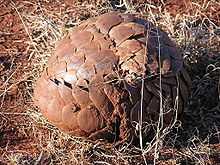Ground pangolin
| Ground pangolin[1] | |
|---|---|
 | |
| A preserved ground pangolin from the collection of The Children’s Museum of Indianapolis. | |
| Conservation status | |
| Scientific classification | |
| Kingdom: | Animalia |
| Phylum: | Chordata |
| Class: | Mammalia |
| Order: | Pholidota |
| Family: | Manidae |
| Genus: | Manis |
| Species: | M. temminckii |
| Binomial name | |
| Manis temminckii Smuts, 1832 | |
 | |
| Ground pangolin range | |
The ground pangolin (Manis temminckii), also known as Temminck's pangolin or the Cape pangolin, is one of four species of pangolins which can be found in Africa, and the only one in southern and eastern Africa. Although it is present over quite a large area, it is rare throughout it and notoriously difficult to spot. Its scarcity is partly because it is hunted by humans for its scales, which are used in love charms, and partly because it is often burnt in bush fires. It is designated as an endangered species by the United States Fish and Wildlife Service,.[3]
With the exception of the underside, it is covered in extremely hard scales. When threatened, it usually will roll up into a ball thus protecting its vulnerable belly. The scales on the tail can also be used as blades to slash at attackers.
The ground pangolin can grow to a length of about 1 m, with the tail typically between 30 and 50 cm. It has a disproportionately small head, powerful hind legs, and small fore legs. Walking is done almost entirely on the back legs with the heavy dragging tail acting as a counterweight.
Like other pangolin species, it is largely nocturnal, although it is also entirely terrestrial, and usually found in savanna or open woodland, generally feeding on termites or ants. It is well adapted to this, with a very long (up to 50 cm) sticky tongue which extends deep into its abdominal cavity. Although it is capable of digging its own burrow, it prefers to occupy disused holes dug by a warthog or an aardvark or to lie in dense vegetation, making it even more difficult to observe.
The animal was named for the Dutch zoologist Coenraad Jacob Temminck.
Image gallery
-

Ground pangolin in the wild in South Africa.
-

Ground pangolin defensive posture.
-

Detail of ground pangolin scales.
-

Detail of ground pangolin foot and claws.
References
| Wikimedia Commons has media related to Manis temminckii. |
| Wikispecies has information related to: Manis temminckii |
- ↑ Schlitter, D. A. (2005). Wilson, D. E.; Reeder, D. M, eds. Mammal Species of the World (3rd ed.). Johns Hopkins University Press. p. 531. ISBN 978-0-8018-8221-0. OCLC 62265494.
- ↑ Pangolin Specialist Group (1996). Manis temminckii. 2006. IUCN Red List of Threatened Species. IUCN 2006. www.iucnredlist.org. Retrieved on 2006-05-11.
- ↑ "Species Profile for Temnick's Ground Pangolin". U.S. Fish and Wildlife Service. Retrieved 2006-09-20.
| |||||||||||||||||||||||||
